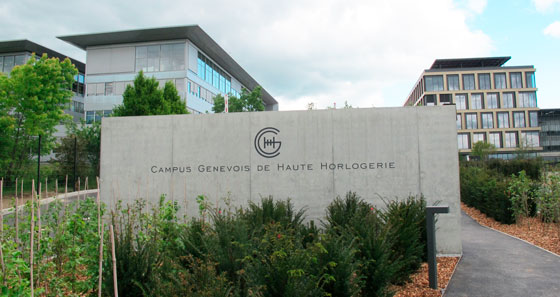
On 24 May, Richemont inaugurated its Genevan prestige watchmaking campus in Meyrin. Five brands, a leather workshop, a school for crafts and craftsmen, the FHH and the group’s European headquarters are all gathered here.
The Campus genevois de haute horlogerie (CGHH) is thriving in the cradle of Swiss watchmaking. Created by Richemont to cultivate excellence in haute horlogerie and to foster the sharing and passing on of knowledge, the CGHH is currently home to some 1,000 employees in five buildings. The dynamic and attractive campus is open to the haute horlogerie industry as a whole, and harbours ambitious plans for future expansion. Training, R&D and innovation coexist alongside manufacturing and administrative activities, as well as initiatives to safeguard and promote watchmaking techniques and artistic crafts, in a fully functioning ecosystem that is unique in the world of watchmaking.
Campus residents
The 45,000 m2 campus currently accommodates nine entities, and that number is set to rise. Cartier, Jaeger-LeCoultre, Roger Dubuis, Vacheron Constantin and Van Cleef & Arpels have relocated selected activities on site. In addition to the Ecole des métiers et artisans de haute horlogerie, this incubator for rare and cutting-edge skills is also home to the Fondation de la haute horlogerie (FHH), the Atelier de maroquinerie leather workshop and Richemont Europe. CGHH expects to accommodate some 1,200 people by 2020.
Passing on knowledge
The Ecole des métiers et artisans de haute horlogerie lies at the crux of the world-class synergy the Campus has to offer. This learning centre is dedicated to passing on watchmaking know-how and skills. It currently provides training and apprenticeships (AFP: Federal Certificate of Vocational Training and CFC: Federal Certificate of Capacity), refresher courses and introductory courses, as well as assessments and skills certifications in watchmaking, micromechanics and artistic crafts. Welcoming apprentices from the haute horlogerie industry as a whole, the school aspires to organise a wide range of training courses, to coordinate the curricula of several schools all over the world, to pass on and certify knowledge, and, of course, to cultivate interest in the crafts of haute horlogerie. 32 students are currently enrolled with the support of a number of maisons (Vacheron Constantin, Roger Dubuis, Piaget, Van Cleef & Arpels, Officine Panerai) and this institution welcomes partnerships with other haute horlogerie brands. By 2020, it will have around 50 apprentices, 7 trainers and 20 new graduates each year.
City within a City
Conceived as a city, the Campus genevois de haute horlogerie was designed by Geneva architects firm De Planta & Portier, which drew up the specifications in 2010. The mini city was purpose-built to incorporate different types of activities (manufacturing, administration and training) and to combine shared facilities (atrium, restaurant, school, auditorium, library and halls) with separate areas used by the maisons. Designed to facilitate interaction and synergies between the diverse members of the watchmaking community, the campus is a flexible project that can be transformed to cater to new requirements. The architectural concept takes the form of a common base punctuated by patio areas for shared activities, with the different buildings fitting together like boxes, which together make up the roads, courtyards and squares of a city within a city.
Role model for sustainability
Since its inception, the CGHH has acted as a role model for the environment and sustainable development. In addition to meeting stringent standards for certification, the Campus is leading the way in sustainability with an impressive claim: the site runs on 100% renewable energy and produces zero carbon emissions. An adiabatic-free cooling system that uses 40 geothermal sensors meets some 80% of annual cooling requirements. Other eco-friendly credentials include 2,600 m2 of photovoltaic solar panels and the use of more than 50% recycled concrete during construction. More than 30% of the site is laid with natural surfaces that cater to local flora and fauna. The promotion of sustainable transport for all residents is pivotal to the eco-friendly concept, and the optimised site layout and transport links, along with the lush landscaping, certainly contribute to the quality of life of every resident.
Cradle of Swiss watchmaking
In choosing to locate the Haute Horlogerie Campus in Meyrin, in the Canton of Geneva, Richemont has reinforced its commitment to the world-renowned cradle of Swiss watchmaking. In creating this centre of excellence to foster skills, knowledge and learning, the international luxury group has cast a vote of confidence in the future. Richemont now plays a more prominent role than ever in the economic fabric of Geneva and Switzerland, at the vanguard of excellence in watchmaking. The group endeavours to make a meaningful contribution to haute horlogerie by safeguarding tradition, nurturing skills and R&D, as well as conserving and updating know-how, a mission which extends to the rarest and most sought-after techniques. True to these ambitions, the objectives of the Campus are to train a new generation of world-class personnel and to raise the profile of haute horlogerie by bringing the leading lights of the industry within reach of the general public.
The leather workshop
Founded in late 2014, the leather workshop is a research and study laboratory as well as a site for the production of limited-edition alligator straps. It offers its services to the group’s brands and ensures traceability of the Louisiana crocodile leather used to produce a watch strap in Meyrin.
June 09, 2016


 News
News